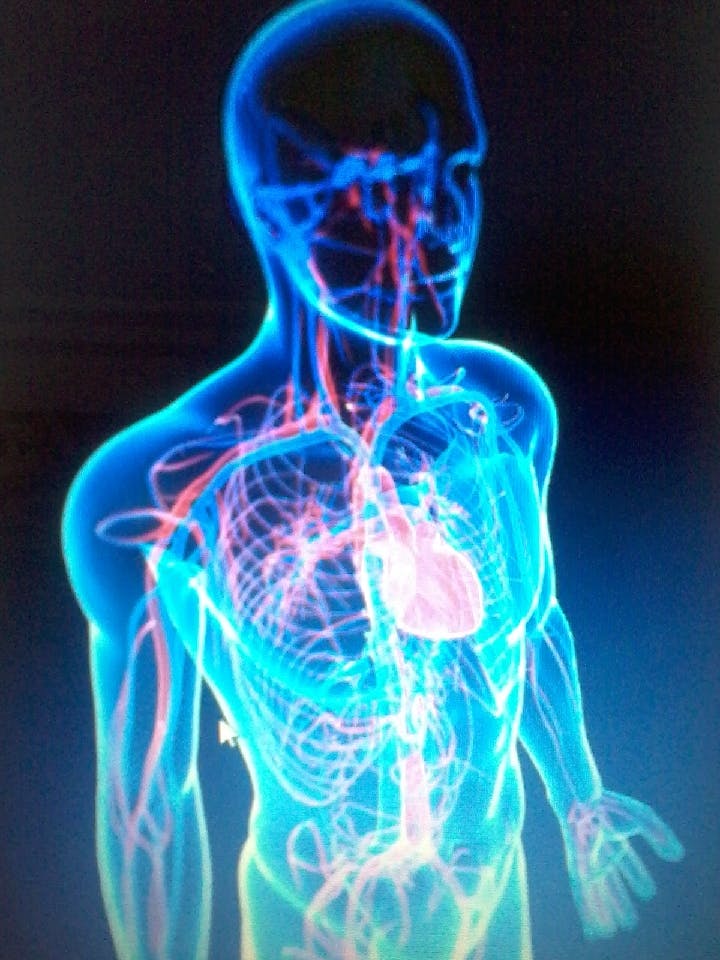Winter 2008
A Day In the Life of a Human Body
– Sharman Apt Russell
A new book examines a day in the life of the body, and reviewer Sharman Apt Russell appreciates its many "intriguing byways—orgasms, napping, the common cold, and nightmares."
Imagine a couple slow-dancing. One partner leads. The other seamlessly follows. Now imagine that time—the natural progression of day and night, morning followed by afternoon and evening—is the lead partner. Imagine your body dancing with time.
In fact, this is happening right now. Your internal clock (a big clock in the brain and smaller clocks scattered in cells throughout the body) keeps track of the passing minutes and signals for certain physical responses. As you move through the day, your body temperature steadily rises, along with your heart rate and blood pressure. Your muscle flexibility increases and your reflexes quicken. The level of the stress hormone cortisol declines. Hormones and neurotransmitters ebb and flow according to the hour, as does your white blood cell count. During the night, the hormone melatonin surges; your temperature, heart rate, and blood pressure fall; and the cortisol level begins to climb so as to peak when you must wake again.
The new research on chronobiology, or the effect of time on our bodies, is so compelling that some scientists suggest we should time-stamp each visit to the doctor. A morning test might not reveal the hypertension of afternoon. Asthma is often worse at night, when adrenaline levels are low and bronchial passages shrink slightly. When we take certain drugs may determine how well they work. Late in the day, higher body temperatures cause medication to break down more quickly. In a recent study of colorectal cancer, the tumors in patients who were given drugs in a conventional steady dose were reduced in size by 30 percent. In patients treated in a chronotherapy regimen—in which drugs are administered at the time of day calculated to maximize their benefit and minimize their toxicity—tumors shrunk by 51 percent, and side effects were less severe.
Science writer Jennifer Ackerman takes us through the most recent discoveries about the body’s natural rhythms, explaining that organisms on earth evolved these rhythms to deal with a rotating planet and its patterns of light and dark, warm and cold. Her larger point is that understanding this dance with time can help us make better choices. Morning is best for activities that require balance and fine motor skills. After reading this book, you might schedule your next medical operation before lunch, when you could expect your surgeon to be at peak efficiency. Late afternoon is when most swimmers and runners set speed records. This is also when your pain tolerance is highest—a good time to be in the dentist’s chair. Sperm concentration is higher in the late afternoon. By early evening, your body is often physically strongest. Later in the evening, you should avoid exercise if you want a good night’s sleep. While these patterns are typical, they can vary. Sleep patterns are particularly individualistic, occurring along a continuum of “larks,” people with peak alert times in the morning, to “owls,” who are most alert in the late afternoon and evening.
Knowledge of the body’s natural rhythms could also influence labor policy. About 15 percent of the American work force now labors through the night—when the body’s clock is signaling sleep. Workers on the graveyard shift may be at higher risk for heart attack and cancer, as well as high cholesterol, high blood pressure, mood disorders, and infertility. They may also be a danger to others. Ackerman connects the major nuclear plant accidents at Three Mile Island and Chernobyl to mistakes made by night-shift workers.
In her account of a day in the life of your body, Ackerman explores a number of intriguing byways—orgasms, napping, the common cold, and nightmares. She provides a cascade of odd facts: Kissing your partner can involve an exchange of five million bacteria, for example, and fetuses yawn in utero. Her astonishment appears to grow with each chapter, and so does ours. Our bodies know just what to do and when to do it. With a languorous dip and a graceful slide, we follow our partner’s lead—a miracle in motion.
* * *
Reviewed: Sex Sleep Eat Drink Dream: A Day in the Life of Your Body. By Jennifer Ackerman. Houghton Mifflin. 253 pp.
Cover image courtesy of Wikimedia Commons
